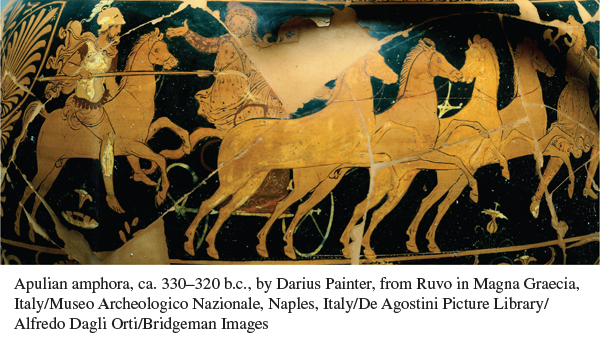Military Campaigns
Despite his youth, Alexander was well prepared to invade Persia. Philip had groomed his son to become king and had given him the best education possible, hiring the Athenian philosopher Aristotle to be his tutor. In 334 B.C.E. Alexander led an army of Macedonians and Greeks into Persian territory in Asia Minor. With him went a staff of philosophers to study the people of these lands, poets to write verses praising Alexander’s exploits, scientists to map the area and study strange animals and plants, and a historian to write an account of the campaign. Alexander intended not only a military campaign but also an expedition of discovery.
In the next three years Alexander moved east into the Persian Empire, winning major battles at the Granicus River and Issus (Map 4.1). He moved into Syria and took most of the cities of Phoenicia and the eastern coast of the Mediterranean without a fight. His army successfully besieged the cities that did oppose him, including Tyre and Gaza, executing the men of military age afterwards and enslaving the women and children. He then turned south toward Egypt, which had earlier been conquered by the Persians. The Egyptians saw Alexander as a liberator, and he seized it without a battle. After honoring the priestly class, Alexander was proclaimed pharaoh, the legitimate ruler of the country. He founded a new capital, Alexandria, on the coast of the Mediterranean, which would later grow into an enormous city. He next marched to the oasis of Siwah, west of the Nile Valley, to consult the famous oracle of Zeus-Amon, a composite god who combined qualities of the Greek Zeus and the Egyptian Amon (see Chapter 1). No one will ever know what the priest told him, but henceforth Alexander called himself the son of Zeus.

Figure 4.1: MAP 4.1 Alexander’s Conquests, 334–324 B.C.E. This map shows the course of Alexander’s invasion of the Persian Empire. More important than the great success of his military campaigns were the founding of new cities and expansion of existing ones by Alexander and the Hellenistic rulers who followed him.
Alexander left Egypt after less than a year and marched into Assyria, where at Gaugamela he defeated the Persian army. After this victory the principal Persian capital of Persepolis fell to him in a bitterly fought battle. There he performed a symbolic act of retribution by burning the royal buildings of King Xerxes, the invader of Greece during the Persian wars 150 years earlier. Alexander continued to pursue Darius, who appears to have been killed by Persian conspirators.
The Persian Empire had fallen and the war of revenge was over, but Alexander had no intention of stopping. Many of his troops had been supplied by Greek city-states that had allied with him; he released these troops from their obligations of military service, but then rehired them as mercenaries. Alexander then began his personal odyssey. With his Macedonian soldiers and Greek mercenaries, he set out to conquer more of Asia. He plunged deeper into the East, into lands completely unknown to the Greek world. It took his soldiers four additional years to conquer Bactria (in today’s Afghanistan) and the easternmost parts of the now-defunct Persian Empire, but still Alexander was determined to continue his march.

Amphora with Alexander and Darius at the Battle of Issus Alexander, riding bareback, charges King Darius III, who is standing in a chariot. This detail from a jug was made within a decade after the battle, in a Greek colony in southern Italy, beyond the area of Alexander’s conquests, a good indication of how quickly Alexander’s fame spread.
(Apulian amphora, ca. 330–320 B.C., by Darius Painter, from Ruvo in Magna Graecia, Italy/Museo Archeologico Nazionale, Naples, Italy/De Agostini Picture Library/Alfredo Dagli Orti/Bridgeman Images)
In 326 B.C.E. Alexander crossed the Indus River and entered India (in the area that is now Pakistan). There, too, he saw hard fighting, and finally at the Hyphasis (HIH-fuh-sihs) River his troops refused to go farther. Alexander was enraged by the mutiny, for he believed he was near the end of the world. Nonetheless, the army stood firm, and Alexander relented. Still eager to explore the limits of the world, Alexander turned south to the Arabian Sea, and he waged a bloody and ruthless war against the people of the area. After reaching the Arabian Sea and turning west, he led his army through the grim Gedrosian Desert (now part of Pakistan and Iran). The army and those who supported the troops with supplies suffered fearfully, and many soldiers died along the way. Nonetheless, in 324 B.C.E. Alexander returned to Susa in the Greek-controlled region of Assyria, and in a mass wedding married the daughter of Darius as well as the daughter of a previous Persian king, a ceremony that symbolized both his conquest and his aim to unite Greek and Persian cultures. His mission was over, but Alexander never returned to his homeland of Macedonia. He died the next year in Babylon from fever, wounds, and excessive drinking. He was only thirty-two, but in just thirteen years he had created an empire that stretched from his homeland of Macedonia to India, gaining the title “the Great” along the way.
Alexander so quickly became a legend that he still seems superhuman. That alone makes a reasoned interpretation of his goals and character very difficult. His contemporaries from the Greek city-states thought he was a bloody-minded tyrant, but later Greek and Roman writers and political leaders admired him and even regarded him as a philosopher interested in the common good. That view influenced many later European and American historians, but this idealistic interpretation has generally been rejected after a more thorough analysis of the sources. The most common view today is that Alexander was a brilliant leader who sought personal glory through conquest, and who tolerated no opposition. (See “Evaluating the Evidence 4.1: Arrian on Alexander the Great.”)

